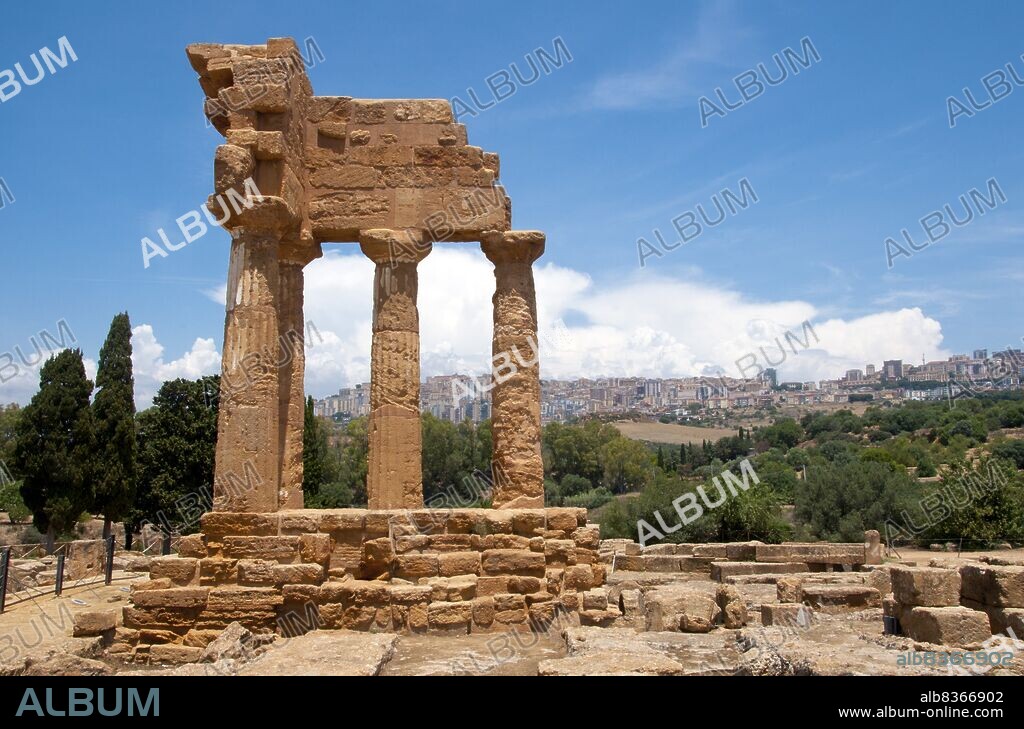alb8366902
Italy: Temple of the Dioscuri (in Greek mythology, the twin brothers Castor and Pollux), originally built mid-5th century BCE, Valley of the Temples (Valle dei Templi), Agrigento, Sicily

|
Zu einem anderen Lightbox hinzufügen |
|
Zu einem anderen Lightbox hinzufügen |



Haben Sie bereits ein Konto? Anmelden
Sie haben kein Konto? Registrieren
Dieses Bild kaufen.
Nutzung auswählen:

Titel:
Italy: Temple of the Dioscuri (in Greek mythology, the twin brothers Castor and Pollux), originally built mid-5th century BCE, Valley of the Temples (Valle dei Templi), Agrigento, Sicily
Untertitel:
Siehe automatische Übersetzung
Agrigento was founded on a plateau overlooking the sea, with two nearby rivers, the Hypsas and the Akragas, and a ridge to the north offering a degree of natural fortification. Its establishment took place around 582580 BCE and is attributed to Greek colonists from Gela, who named it 'Akragas'.
. Akragas grew rapidly, becoming one of the richest and most famous of the Greek colonies of Magna Graecia (Greater Greece). It came to prominence under the 6th-century tyrants Phalaris and Theron, and became a democracy after the overthrow of Theron's son Thrasydaeus.
. Although the city remained neutral in the conflict between Athens and Syracuse, its democracy was overthrown when the city was sacked by the Carthaginians in 406 BCE. Akragas never fully recovered its former status, though it revived to some extent under Timoleon in the latter part of the 4th century.
. Akragas grew rapidly, becoming one of the richest and most famous of the Greek colonies of Magna Graecia (Greater Greece). It came to prominence under the 6th-century tyrants Phalaris and Theron, and became a democracy after the overthrow of Theron's son Thrasydaeus.
. Although the city remained neutral in the conflict between Athens and Syracuse, its democracy was overthrown when the city was sacked by the Carthaginians in 406 BCE. Akragas never fully recovered its former status, though it revived to some extent under Timoleon in the latter part of the 4th century.
Bildnachweis:
Album / Universal Images Group / David Henley / Pictures From History
Freigaben (Releases):
Model: Nein - Eigentum: Nein
Rechtefragen?
Rechtefragen?
Bildgröße:
5064 x 3341 px | 48.4 MB
Druckgröße:
42.9 x 28.3 cm | 16.9 x 11.1 in (300 dpi)
Schlüsselwörter:
5. JAHRHUNDERT • 5. JH. • ALT (ALTER) • ALTERTÜMLICH • ANTIK • ARCHITEKTUR • EUROPA • EUROPAEER (F M) • EUROPAEER • EUROPÄER (F M) • EUROPÄER • EUROPÄISCH • GREECE • GRIECHE • GRIECHENLAND • GRIECHIN • GRIECHISCH • HELLENISTISCH • ITALIEN • ITALIENER • ITALIENISCH • RUINE • RUINEN • STADT • STÄDTE • TEMPEL • ZERFALL
 Pinterest
Pinterest Twitter
Twitter Facebook
Facebook Link kopieren
Link kopieren Email
Email
